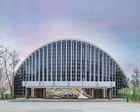A new architectural guidebook was written as a love letter to the Ukrainian city – then Russia started bombing it. How will this home to Tetris-like offices and daring curved cinemas be rebuilt?
When the Derzhprom building erupted on to the Kharkiv skyline in the 1920s, it must have seemed like an impossibly futuristic vision. Standing like a gleaming white concrete castle, it curves around the circular plaza of Freedom Square in the city’s centre.
Built as the state industry headquarters of what was then the capital of the Ukrainian Soviet Socialist Republic, it looks like a three-dimensional game of Tetris, a mighty nest of chunky oblong forms stacked, rotated and interlocked to form a colossal administrative pile. Striding across three city blocks, and towering almost 60m high, it was the tallest office building in Europe for several years, its humungous floor plates connected high up in the air by thrilling sci-fi skybridges. It was far ahead of its time, prefiguring the brawny brutalist complexes that emerged in western Europe and the US half a century later.



















